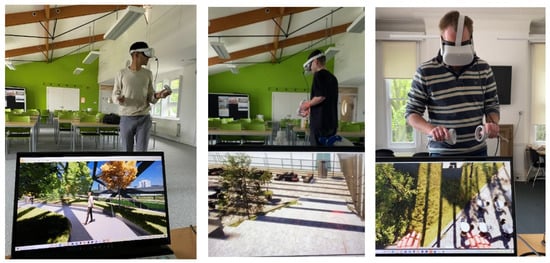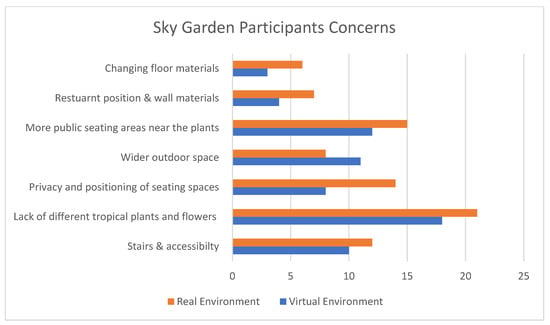Your browser does not fully support modern features. Please upgrade for a smoother experience.
Please note this is an old version of this entry, which may differ significantly from the current revision.
Subjects:
Architecture And Design
Virtual reality (VR) technology has the potential to revolutionize public engagement in the design of urban projects, leading to more sustainable and inclusive environments.
- virtual reality
- computational design
- gamification
- participatory design
1. Circulation
The analysis of the space circulation design theme in elevated urban spaces revealed a range of perspectives from participants in both the real-world walk-along interviews and the VR experiment. To gain a deeper understanding of the complexities of this design element, it is crucial to consider and compare the similarities and differences between the physical and virtual environments. The one-way circulation system in the Sky Garden, for instance, garnered mixed responses from participants in both environments (Figure 1). Some participants (n = 28) acknowledged its necessity during pandemics and post-crisis, asserting that it facilitated a more focused and undisturbed appreciation of the views. One participant in the real environment remarked, “The one-way circulation was okay. I think it works really well as it makes you concentrate more on the views and you are less bothered by the people walking around you” (female, aged 33 years, living in London). Conversely, several participants (n = 38) found the one-way circulation system restrictive, expressing frustration with having to traverse the entire path again if they missed a particular city view, as one participant stated that “if you pass something on the left and you want to see it again you must go around again. I guess that was a little bit annoying, so I went around a couple of times” (male, aged 27 years, living in London).

Figure 15. Participants’ circulation in the real environments of both the Sky Garden and Crossrail Place during the walk-along interviews. Source: author.
With respect to the different levels and accessibility in the Sky Garden, participants in both the real environment and the VR experiment enjoyed navigating between the varying heights (Figure 6). However, they concurrently expressed concerns regarding the limited accessibility for disabled and wheelchair users. In the VR experiment, participants (n = 21) who had not previously visited the Sky Garden appreciated the experience of ascending the stairs virtually, with one stating, “I liked going up the stairs to different levels; it gave me the feeling of hiking or climbing a mountain and trying to experience different platforms” (a participant that had not previously visited the Sky Garden). However, they also suggested implementing accessible ramps or a stair platform lift as an alternative to accommodate wheelchair users: “Virtually, the space circulation is clear and easy to move around, but physically, because of the stairs in London Sky Garden, it might be a bit difficult for people with physical disabilities to move around” (landscape designer).

Figure 6. Participants’ circulation in the virtual environments of both the Sky Garden and Crossrail Place during the VR experiment.
When exploring participants’ preferences in the VR experiment, the responses diverged (Figure 7 and Figure 8). A significant number of participants (n = 20) expressed a preference for the Sky Garden’s circulation due to its open floor plan, glass facade, and symmetrical layout. Conversely, a smaller group of participants (n = 13) favored the Crossrail Place circulation, citing the curvy and multiple pathways as factors that contributed to a more natural and engaging park-like experience. One participant commented, “For Crossrail Place, it feels like you are walking and discovering space more like in a winter garden” (interior designer).

Figure 7. Bar chart illustrating the number of participants’ concerns (out of a maximum of 33) in both the real and virtual environments of the Sky Garden.

Figure 8. Bar chart illustrating the number of participants’ concerns (out of a maximum of 33) in both the real and virtual environments of Crossrail Place.
Lastly, the curved pathways in Crossrail Place were highlighted by participants in both the real environment and the VR experiment (Figure 5 and Figure 6). These individuals appreciated the organic and intriguing feel of these pathways compared to more linear and symmetrical circulation systems. However, they also observed that the pathways were narrow, potentially confusing for first-time visitors, and lacked adequate privacy for those sitting on benches. In the VR experiment, participants suggested widening the pathways to address these concerns and to improve accessibility: “In Crossrail Place, I felt that the width of the pathways was too narrow for people to move. I really like the whole idea physically; the gardens and the landscape features were fantastic. Personally, I prefer the Crossrail Place circulation and I think the curves add a bit of adventure to the public space” (an urban designer that had not visited the Crossrail Place roof garden before).
2. Design Considerations
Upon examining the design concerns derived from the participants in the real environment and the VR experiment, several critical insights surfaced, emphasizing the parallels and distinctions between the physical and virtual realms. Both participant groups pinpointed various design concerns and limitations in the Sky Garden and Crossrail Place. Most participants (n = 30) in the VR experiment acknowledged the effectiveness of the virtual circulation method in simulating the physical environment. The method enabled them to gain a detailed overview of different design aspects, such as a sense of scale, lighting, materials, and furniture organization. Participants without a background in architecture or urban design were also able to express their views on the design limitations and to get involved in editing and testing their ideas in real-time, demonstrating the value of virtual reality as a tool for design evaluation.
Regarding the Sky Garden design, a significant number of VR participants (n = 26) identified their limitations and concerns, which paralleled those of participants in the real environment (Table 4). These design limitations included providing more green areas and public seating spaces near plants and redesigning the organization of seating areas for more privacy, social distancing, and accessibility. There were also concerns about the design and materials in the restaurant and the outdoor viewing platform. In the physical experience of the Sky Garden, 85% of the participants (n = 28) reported concerns about the design of the space and suggested improvements for a better visiting experience. Common themes echoed those of the VR participants, including design concerns related to the privacy and positioning of seating spaces, the lack of different tropical plants and flowers, stair accessibility for disabled people, outdoor terrace design, and restaurant design.
Many participants (n = 18) in the VR experiment preferred Crossrail Place due to its green, natural, and landscape features, describing it as “more public” than the Sky Garden. Participants in both the real environment and the VR experiment again expressed similar concerns, such as the need for comfortable and sociable seating areas, wider pathways for privacy and accessibility, and more plants and flowers. Data from the Crossrail Place real environment highlighted several concerns that were also identified by VR participants, such as the lack of shaded areas to protect visitors from inclement weather, narrow pathways, uncomfortable seating benches, poor visual accessibility, and a lack of social interaction. Many participants in the real environment also mentioned the absence of public toilets on the roof garden level, necessitating visitors to go to the ground floor (Figure 8).
In conclusion, participants in both the real environment and the VR experiment identified various design concerns and limitations in the Sky Garden and Crossrail Place, illustrating the similarities between the physical and virtual worlds. The virtual circulation method effectively simulated the real environment experience, enabling participants to provide valuable feedback for potential improvements.
3. Activities and Participant Interaction
In the virtual Sky Garden, participants anticipated engaging in activities such as enjoying city views, having a drink, eating, meeting friends, and taking photographs. Meanwhile, at Crossrail Place, they expected more relaxation-oriented activities, including enjoying the plants and natural environment, reading, eating lunch, and taking photographs. Participants generally appreciated the virtual environment exploration in both spaces, with many recognizing its potential for additional virtual activities. They valued the ability to explore and test the space without physically being there and suggested offering free virtual tickets to attract more visitors to the physical locations. A substantial number of participants who had not visited either garden indicated that the VR experience made them more interested in visiting in person.
The majority of the participants (n = 31) noted that the VR experience provided a sense of confidence and freedom to explore various physical and virtual activities, such as jumping, flying, dancing, running, and sitting on the floor. The VR environment stimulated their senses and encouraged interaction with the design features and objects, helping them understand their needs and preferences within the space. However, the absence of other sensory experiences, such as touch, air movement, and smell, was seen as a barrier to creating a fully immersive experience (Figure 9). One academic participant, for example, stated that: “I suppose that VR also affords magical possibilities: such as the fact that I could fly, I can go through the ground, stand on a sofa, can do things that I can’t do in the real world. So, if you put these various things together, you are not going behave in any form of regulated way”.

Figure 9. Participants’ interaction with the virtual environment.
Interestingly, many participants (n = 29) expressed a sense of loneliness in the virtual space, preferring to share the experience with others, such as friends, family, or the public. They enjoyed observing static human models in Crossrail Place and suggested additional social activities, such as online gatherings, meetings, webinars, and using the space as a social platform (Figure 9). Participants also expressed interest in more interactive experiences, such as playing games or watching movies with others. Some participants, reflecting on their lockdown experiences, acknowledged the potential of VR as an online social platform for use in future pandemics. While they recognized that virtual socialization could not fully replace physical experiences, they believed it could positively impact the mental health of individuals living alone during pandemics. Indeed, a participant that had previously visited both places noted that:
“From my point of view in terms of mental health, especially during the lockdown, it (VR experience) could make a big change, especially for people living alone. It will definitely be suggested, I think it’s an enjoyable element that can bring more happiness and change people’s mood if they use space to socialise with others.”
This entry is adapted from the peer-reviewed paper 10.3390/su15129184
This entry is offline, you can click here to edit this entry!
